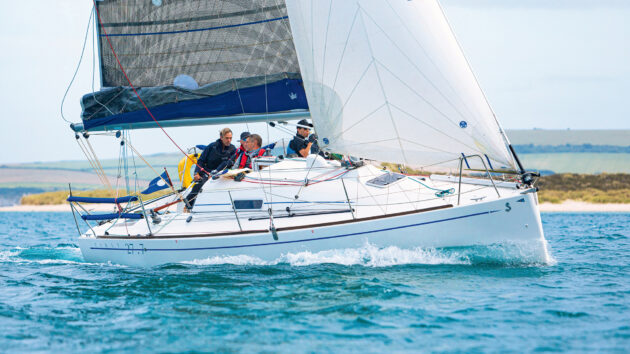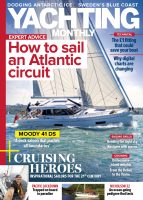A fast and capable lift-keeler, then Beneteau First 27.7 is the brand's ‘mini IMOCA’, which combines features of an offshore racer and a shoal-draught cruising yacht
Beneteau First 27.7 used boat review: Fast, fun, and still very capable
Now and again you come across a boat that occupies a very particular niche in the market. The Beneteau First 27.7 is undoubtedly such a boat.
It’s hard to think of anything else of similar size that does what the 27.7 does for a similar budget. Do you want a boat with a racing pedigree, a lifting keel and the ability to plane downwind? In that case you might look at the Seascape 27 (now under the Beneteau umbrella and sold as the First 27) or a Mojito 880. Both are much newer than the First 27.7 – still built, in fact – and a lot more expensive.
Alternatively, if you’re happy with an older lift-keeler and you’re not fussed about double-digit speeds under spinnaker, you have a wider choice. How about a Parker 27 or 275? Or perhaps a Kelt 850/29, or yet another Beneteau in the form of the First 285?
Should a lifting keel not be on your list, you might consider Jeanneau’s Sun Fast 26, a Django 8S or a Pogo 850. Plenty of boats do some of what the 27.7 does. Finding one that does everything would be more of a challenge, however. That’s one reason why you don’t find many 27.7s on the market – particularly in the UK, home to fewer than 20 of the 600 or so that Beneteau built.
Maybe she didn’t sell desperately well over here because one or two early reports suggested she could be quite a handful for anyone who hadn’t been brought up sailing performance dinghies.
Having flown the spinnaker in 25 knots of wind during our test sail, when we hit an easy 12.5 knots, I would maintain that she’s remarkably forgiving and easy to handle in a breeze. I should perhaps admit to being used to performance dinghies and to having spent more time racing than cruising in recent years. Nonetheless, I would argue that the First 27.7 is by no means only suited to people with a dinghy-racing background.

Plenty of space for a cruising or racing crew in the large cockpit. Photo: David Harding / SailingScenes.com
A performance pedigree
On ‘fun days out’, David Lush, co-owner of Moon Shadow with Thijs Knapper, said that the crew on occasions has sported seven new knees and hips between them and has still been surfing at 12 knots while drinking coffee. That sounds like a pretty civilised way to go sailing, wherever your interests lie.
Although the 27.7 makes an excellent fast cruiser, she undeniably has a race-boat pedigree. Her designers, Groupe Finot (now Finot-Conq) draw parallels between her and their string of highly successful IMOCAs (the 60-footers used in the Vendée Globe).
IMOCAs designed by Finot won the Vendée Globe on four successive occasions, from 1992 to 2004, before Alex Thomson on another Finot design, Hugo Boss, set a new 24-hour distance record of more than 500 miles. The designers have also had notable success in the Mini Transat with the Mini 6.50s.

Conceived with short-handed offshore sailing in mind, the First 27.7 is also well suited to club racing. Photo: David Harding / SailingScenes.com
Designed in 2002, the 27.7 bears more than a passing resemblance to the IMOCAs of that era. She has a fine entry – this was before the widespread use of the scow bow – a broad stern and a deep, high aspect-ratio keel with a lead bulb.
While Beneteau offered her in fin keel form too, with a draught of 1.8m (5ft 11in), most have the vertically-lifting option. That gives a draught of 2.1m (6ft 11in) with the keel down and 0.65m (2ft 1.5in) when it’s raised.
The 600kg (1,323 lb) lead bulb on the bottom of the composite keel shaft ensures a low centre of gravity with minimal weight. At 2,795kg (6,162 lb), the lift-keeler is 200kg (440 lb) lighter than her fin keeled sister: when the ballast is that low, you need less of it.
Article continues below…
It will be clear by now that the 27.7 is not a boat to consider if your primary interest is tootling around the harbour and winding the keel up a few inches when it starts to get shallow. With the keel pinned in its down position, she’s effectively a fin-keeler.
It’s not a massive job to remove the pins and raise it with the electrically-operated hydraulic pump, but you wouldn’t normally do that until you’re back on your mooring or in your berth. It’s really a keel that’s either up or down.
The First is a big, fast and powerful boat for her length, able to compete with (and beat) many earlier-generation 32-footers in most departments. She’s sporty and serious, and functional rather than plush below decks, with a keel-stepped mast and a keel that dominates the cabin when it’s raised.

With full main and spinnaker in 25 knots of breeze, hitting double-digit speeds was neither difficult nor hair-raising. Photo: David Harding / SailingScenes.com
A view to race
Beneteau launched her in 2002 with a view to establishing a short-handed racing circuit. Although this never happened, there’s no doubt that the 27.7 is a highly capable performer.
That doesn’t, however, mean that she’s necessarily going to win in club racing.
David and Thijs, who both spent time in one-designs with the J/24s, knew that when they bought Moon Shadow. ‘We wanted a boat that sailed nicely,’ explained David, ‘and we were prepared to accept the compromise of struggling under handicap. Handicaps are always a bit of a fudge, and this boat is not a handicap bandit.’

Below decks, the layout is dominated by the keel, its case, the compression post for the lifting system and the keel-stepped mast. Photo: David Harding / SailingScenes.com
By way of illustration, under the VPRS (Velocity Prediction Rating System) that’s widely used in Poole, the 27.7 has to give six minutes an hour to the Impalas. Her substantial wetted area means that sailing 10% faster is a challenge, certainly until the breeze picks up.
Had she been built to her designed weight, the wetted area would be less of an issue. The fact that Moon Shadow’s transom is well immersed at rest suggests that she’s substantially heavier than her designer intended.
Steady at speed
In case all this talk of racing might sound off-putting, let’s move on to what she’s actually like to sail. To find out, I went for a spin in Moon Shadow with David and Thijs one brisk and breezy day. There were actually five of us on board, because it was a rather nice day for a sail; not because we needed five pairs of hands.

A good chart table for a boat of this size, with stowage, space for instruments, and the keel’s hydraulics underneath. Photo: David Harding / SailingScenes.com
As it was blowing about 25 knots, we started with the No2 jib and two slabs in the main. The boat was very comfortable as we reached out of the harbour at just under 8 knots. Once past the chain ferry, we reckoned she could take a little more, so we shook out one of the reefs.
Having to de-power from time to time was of little consequence. What mattered was that she didn’t mind being pushed harder, the deep, transom-hung rudder providing an impressive amount of grip. Importantly, the cassette stock allows the blade to be balanced through the tiniest amount of fore-and-aft movement at the top. It’s nice and light if you get it right; rather heavier if you don’t.

No frills in the galley; just the basics, including a single-burner gas hob. Photo: David Harding / SailingScenes.com
Taking stock
The welded aluminium stock has been known to fail – one owner had a lucky escape on a breezy day in Hurst Narrows – so David and Thijs had theirs dye-tested. They also made some modifications to the rudder arrangements.
The blade’s lifting line attaches to the backstay, which used to be a lever type before they converted it to a cascade and shortened the standing part to raise the lifting point. That allowed the blade to be lifted clear of the water, whereas previously the bottom stayed immersed and grew weed.
Confident that the rudder was going to remain attached to the boat – and that the boat would respond to the rudder – we had no hesitation, on reaching the end of the channel, in bearing away and hoisting the kite. A breeze gusting to 27 knots (as recorded on the nearest weather beacon) might have made things lively on some boats, but the First felt as steady as a rock.

A symmetrical spinnaker allows deep downwind angles to be sailed, and the boat’s stability makes for
relatively straightforward gybing. Photo: David Harding / SailingScenes.com
To be fair, with a fully race-honed crew we would have cranked things up a notch or two by squaring the pole back and letting the kite fly a little higher. Given that we were sailing conservatively, the boat acquitted herself well, clocking up to 12.5 knots and never giving us the slightest cause for concern.
In the 2023 Round The Island Race she hit over 14 knots surfing down the waves, and the designer’s polars (assuming flat water) show her capable of hitting 16 knots under spinnaker when the wind exceeds 35 knots.
While that might be achievable on paper, I wonder how likely it would be in practice even if you did have a bulletproof spinnaker and good insurance cover for the rig. With The Needles drawing ever closer, we reluctantly dropped the kite, tucked the first slab back in the main (we had shaken it out on the way downwind) and turned to beat our way back across the bay.
Again, the boat performed well, making speeds in the mid-5s hard on the wind and with a nicely responsive helm. With the tiller extension in one hand, you have a comfortable helming position on deck where the cockpit widens abaft the cockpit seats.

The mast passes through a raised moulding on deck, which also incorporates a dorade vent and the instrument housing. Photo: David Harding / SailingScenes.com
Handling the power
The mainsail’s sheeting arrangement varies between boats. On Moon Shadow, it had originally been handled directly from the full-width traveller across the transom.
That would make it hard to reach for anyone other than the helmsman, whereas leading the tail forward along the boom and then down to a swivel jammer on the stainless turret on the cockpit sole brings it to hand for either the helm or a dedicated trimmer (often one of the youth crew that Thijs has been coaching for the annual match-racing challenge between Parkstone and Poole yacht clubs).
Hardware throughout is all in the right places, as you would expect on a performance boat from Beneteau, even if bigger winches wouldn’t go amiss.

A long traveller runs across the transom, from where the sheet is led along the boom and down to a swivel jammer on the cockpit sole. Photo: David Harding / SailingScenes.com
Once you’ve got everything trimmed, the polars suggest that you might achieve an upwind VMG of up to 4.8 knots. Just don’t try hanging on to full main for too long. On some boats you can get away with it, especially when you have a full crew on the rail (which we didn’t). On the 27.7, ‘blading’ the main (flattening and de-powering it) isn’t enough, and you’re better off taking in a slab.
Instruments to help you see the effects of your tweaking can be mounted on the bulkhead either side of the companionway and in the moulded housing that will accommodate a standard 4in display just abaft the mast.
Forward of the instrument housing is a dorade vent, a welcome and unusual feature to find on a boat of this size.
Despite having been in cruising mode, when we checked afterwards we saw that we had averaged 6.5 knots on our 15-mile spin around the bay; not bad at all for a 27-footer.

Wide sidedecks are edged by a wooden toerail. The inboard headsail tracks allow a narrow sheeting angle. Photo: David Harding / SailingScenes.com
Taking a quick turn around the deck, we find an anchor well in the bow, a wooden toerail edging the decks, the jib tracks on their inboard side, inhaulers for greater control of sheeting angles, and a large locker to starboard in the cockpit.
Beneteau First 27.7 specifications
DESIGNER: Groupe Finot
BUILT: 2002-2008
PRICE: £25,000-£35,000
LOA: 7.99m / 26ft 2.5in
LWL: 7.99m / 26ft 2.5in
BEAM: 2.54m / 8ft 4in
DRAUGHT: Keel down 1.95m / 6ft 4in Keel up 0.95m / 3ft 1in
DISPLACEMENT: 1,380kg / 3,042 lb
BALLAST: 1 610kg / 1,345 lb
SAIL AREA: 48.0m2 / 516 sq ft
Enjoyed reading this?
A subscription to Yachting Monthly magazine costs around 40% less than the cover price, so you can save money compared to buying single issues.
Print and digital editions are available through Magazines Direct – where you can also find the latest deals.
YM is packed with information to help you get the most from your time on the water.
-
-
- Take your seamanship to the next level with tips, advice and skills from our experts
- Impartial in-depth reviews of the latest yachts and equipment
- Cruising guides to help you reach those dream destinations
-
Follow us on Facebook, Twitter and Instagram.
Verdict
We haven’t discussed the accommodation, because that’s not what you would buy a First 27.7 for. She provides a good deal of space nonetheless, with a generous aft cabin, a settee berth either side of the keel and an up-and-over berth in the bow, plus a perfectly workable galley and chart table. On the other hand, it feels fairly spartan down here and you have to be mindful of the structural frames under your feet. Then there’s the keel-stepped mast at the forward end of the keel case, and the post at the aft end for the lifting mechanism. This seems to be a carefully engineered boat, with the loads from the rig, mast and keel well distributed. There’s no headlining, because the deck is vacuum-infused. If you don’t mind the emphasis being firmly on the functional below decks, and are more interested in the performance and ease of handling, a 27.7 might be an excellent choice. She’s a lot of fast fun and, more than 20 years after her launch, there are still very few boats out there capable of competing with her.





